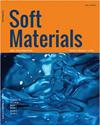The inclusion of a salicylate derivative in polyurethane structures and its effect on the properties and the stability of polyurethanes exposed to weathering
IF 1.6
4区 材料科学
Q4 MATERIALS SCIENCE, MULTIDISCIPLINARY
引用次数: 0
Abstract
ABSTRACT Polyurethanes are highly sought after polymer materials due to their exceptional properties. These properties can be expanded by including 2-hydroxyethyl salicylate in its chemical structure in order to obtain active polymer materials with anti-inflammatory and analgesic properties. These polymers can be used in the manufacture of footwear, stockings and clothing. Furthermore, in order to improve mechanical properties, glycerol and its derivatives with various hydroxy-aliphatic chains can be incorporated into the polyurethanes. Changing the chemical structure of the hard segment (through chain extender amount and crosslinker’s structure) may yield improved or modified properties and uses for these polyurethanes, which can be identified by investigating the structure–property relationships for these materials. The incorporation of a crosslinker with longer hydroxy-aliphatic chains (glycerol ethoxylate (Star-PEG)) has significantly improved the mechanical resistance of the polyurethane. At the same time, Star-PEG-polyurethane preserved its very good properties after a year of outdoor environmental exposure, without exposure to direct sunlight. The inclusion of the salicylate component in the polyurethane hard segments develops new and interesting ways to obtain polyurethane elastomers for biomedical applications. We intend to study in detail the medical properties of these polyurethane materials and their maintenance over time in a future paper.水杨酸盐衍生物在聚氨酯结构中的包合及其对耐候性聚氨酯性能和稳定性的影响
聚氨酯是备受追捧的高分子材料,由于其特殊的性能。这些特性可以通过在其化学结构中加入2-羟乙基水杨酸酯来扩展,以获得具有抗炎和镇痛特性的活性高分子材料。这些聚合物可用于制造鞋袜和服装。此外,为了改善聚氨酯的机械性能,甘油及其具有各种羟基脂肪链的衍生物可以加入到聚氨酯中。改变硬段的化学结构(通过扩链剂的数量和交联剂的结构)可能会改善或改变这些聚氨酯的性能和用途,这可以通过研究这些材料的结构-性能关系来确定。具有较长羟基脂肪链的交联剂(甘油乙氧基酸酯(Star-PEG))的掺入显著提高了聚氨酯的机械阻力。同时,star - peg -聚氨酯在室外环境暴露一年之后,在没有阳光直射的情况下,仍能保持其非常好的性能。在聚氨酯硬段中加入水杨酸盐组分开发了新的和有趣的方法来获得用于生物医学应用的聚氨酯弹性体。我们打算在未来的论文中详细研究这些聚氨酯材料的医用性能及其随时间的维护。
本文章由计算机程序翻译,如有差异,请以英文原文为准。
求助全文
约1分钟内获得全文
求助全文
来源期刊

Soft Materials
工程技术-材料科学:综合
CiteScore
2.90
自引率
0.00%
发文量
21
审稿时长
2.2 months
期刊介绍:
Providing a common forum for all soft matter scientists, Soft Materials covers theory, simulation, and experimental research in this rapidly expanding and interdisciplinary field. As soft materials are often at the heart of modern technologies, soft matter science has implications and applications in many areas ranging from biology to engineering.
Unlike many journals which focus primarily on individual classes of materials or particular applications, Soft Materials draw on all physical, chemical, materials science, and biological aspects of soft matter. Featured topics include polymers, biomacromolecules, colloids, membranes, Langmuir-Blodgett films, liquid crystals, granular matter, soft interfaces, complex fluids, surfactants, gels, nanomaterials, self-organization, supramolecular science, molecular recognition, soft glasses, amphiphiles, foams, and active matter.
Truly international in scope, Soft Materials contains original research, invited reviews, in-depth technical tutorials, and book reviews.
 求助内容:
求助内容: 应助结果提醒方式:
应助结果提醒方式:


